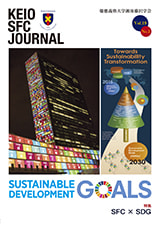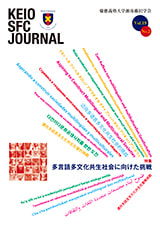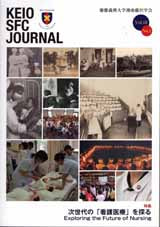- HOME
- KEIO SFC JOURNAL
- Vol.19 No.1

SFC × SDG
-
Foreword
Download this article (PDF) :SFCJ19-1-00.pdfNorichika Kanie (Professor, Graduate School of Media and Governance, Keio University)
-
Internet Environment for Research Platform of SDGs
Keisuke Uehara (Associate Professor, Faculty of Environment and Information Studies, Keio University) Jun Murai (Professor, Faculty of Environment and Information Studies, Keio University) oT is important for promoting SDGs. SFC has greatly contributed to the research on Internet and IoT. As a result, SFC also has contributed to the digital society recently. To promote SDGs, measurement and feedback are essential; this includes knowledge on digital data handling, which is cultivated through InternetCAR project, Auto-ID project, Scanning the Earth project, and Safecast project at SFC.
Download this article (PDF): SFCJ19-1-01.pdf -
Digital Fabrication × SDGs - Basic Concepts of "FabCity"
Hiroya Tanaka (Professor, Faculty of Environment and Information Studies, Keio University) Yuuka Watanabe (Part-time Lecturer, Keio University SFC) The roles of Fab Lab (fabrication laboratory), originally known as "space for making things", are in dynamic transitions now. Digital fabrication technologies realize direct translation between digital 3D data and physical object, then replace physical logistics as virtual transmission. Local Fab Labs are leading material recycling, self-sufficient city and circular economy. Fab Labs are not just targeting at making things, but targeting at appropriate production and social changes. In this paper, we describe "Fab City", the next important concept of Fab Lab, in relationship with SDGs.
Download this article (PDF): SFCJ19-1-02.pdf -
SDGs are the First Communication Design in the UN - Consider From the Production Process of SDGs Icon Japanese
Masahiro Kawatei (Associate Manager, Group PR & IR Division, Hakuhodo DY Holdings Inc.) The SDGs was adapted at UN Summit. UN Headquarters then launched the communication with colorful 17 icons. The issue of environmental communication till now was that people do not take actions though they recognize the issues. Therefore, I have verified the connection between recognition and action by reviewing the production process of the Japanese version of SDGs icons. The standardization of the Japanese version of SDGs icons, created by the cross-sectoral dialogues, gathered the greatest common divisor of Japanese, and released by a public institution, prevented creating multiple Japanese icons while expanded the users. The result suggests a possibility that the approach strengthens the action from issue recognition.
Download this article (PDF): SFCJ19-1-03.pdf -
Certification Programmes and Their Contribution to the SDGs
Mari Kosaka (Senior Researcher, Keio Research Institute at SFC) This paper explores how three certification programmes with a third-party verification process (Forest Stewardship Council, Marine Stewardship Council and Fair Trade) help to achieve the Sustainable Development Goals, using a framework based on institutional interactions. Research findings include that rules of those programmes are in line with 91 SDG targets, covering three aspects of sustainable development. As the programmes provide both rules align with the SDGs and its implementation process, this paper proposes that the certification programmes may be one of the means to implement the SDGs.
Download this article (PDF): SFCJ19-1-04.pdf -
The SDGs and Business - An Attempt to Forge the Best Practice of Ryohin Keikaku (MUJI)
Mitsuru Kawamoto (Project Assistant Professor, Graduate School of Media and Governance, Keio University) The "governance gap" in the institutional structure of global governance, which continues to aggravate human rights problems and environmental problems amongst others, is recognized today. This is about the issues on regulations on global enterprises, which partly contributed to cause global problems. In order to fulfill the gap, as governance strategy, international community employed soft law strategy based on non-binding and influential agreements such as 'principle' or 'guideline' amongst others. Today, global companies (or multinationals) are simultaneously contributing to problem-solving of global issues through business by utilizing SDGs, at the same time, signing such principles as UN Global Compacts (UNGC), Principles for Responsible Investments (PRI) and Guiding Principles on Business and Human Rights (UNGP) amongst others, which is reckoned as contributing to the fulfillment of such gaps. In this regard, the SDGs are becoming to function as a tool to facilitate effective communication among stakeholders for promulgating their efforts. The business case of Ryohin Keikaku (well known as MUJI) shows a good practice of this, which is expected to become a good practice of such efforts. And, the case of Ryohin Keikaku (MUJI) has a great potentiality to become one of the best practices of SDG business.
Download this article (PDF): SFCJ19-1-05.pdf
-
[Research Articles] An Analysis of Daily Life in the Aynu Prosaic Folktales - Towards the Study of Aynu (Human) Security
Shintaro Yamada (Second year of Master's degree, Integrated Human Sciences Program for Cultural Diversity, Department of Area Studies, Graduate School of Arts and Sciences, The University of Tokyo) This paper focuses on the reconstruction process of people's daily life in Aynu prosaic folktales and studies the way of reconstruction of everyday life in the indigenous society. In addition, I try to point out that their way of life reconstruction is also important in the task of reconstructing livelihoods in modern society. Through the consideration of contemporary concepts from the indigenous society, it is also important for us living in a modern society to know that the knowledge fostered by the indigenous society.
Download this article (PDF): SFCJ19-1-06.pdf -
[Research Articles] Proposal of Evaluation Method of Individual Care Tools Based Nursing Care
Junki Yoshioka (Senior Researcher, Keio Research Institute at SFC) Shoko Miyagawa (Associate Professor, Faculty of Nursing and Medical Care, Keio University) In this research, we examined a method to evaluate a "new" design to support nursing care tailored to individual needs. We interpreted design the tool based on individual care, as a part of the nursing process, by using linkages based on the North American Nursing Diagnosis Association International (NANDA-I) approved nursing diagnosis and deriving Nursing Interventions Classification (NIC) and Nursing Outcome Classification (NOC). We demonstrated concrete procedures to evaluate the results of care tools based on individual needs, in the context of nursing care, and proposed of evaluation method of individual care tools based on nursing process.
Download this article (PDF): SFCJ19-1-07.pdf -
The Impact of the Relative Age Effect in Japan - A Field Verification of Grade 4th to 9th Students
Aya Uemura (Doctoral Program, Graduate School of Media and Governance, Keio University) This paper examines Relative Age Effect (RAE) in Japan, where school entry rule is strictly enforced without any reasonable accommodations. The data size is around 300,000 in 4th-9th grades, collected by Japanese local government, as complete survey, which contains 3 years' math and Japanese standardized subject test result. By regression analysis, RAEs observed statistically significant especially for youngest cohort in Japanese school year (born in January-March), for all grades, both math and Japanese, boys and girls. The gap for relatively youngest cohort, at grade 4, is around 3.0 on deviation value, which decrease as they grow up, but remain more than 1.0, at 9th grade, which is stronger than the past researches.
Download this article (PDF): SFCJ19-1-08.pdf

